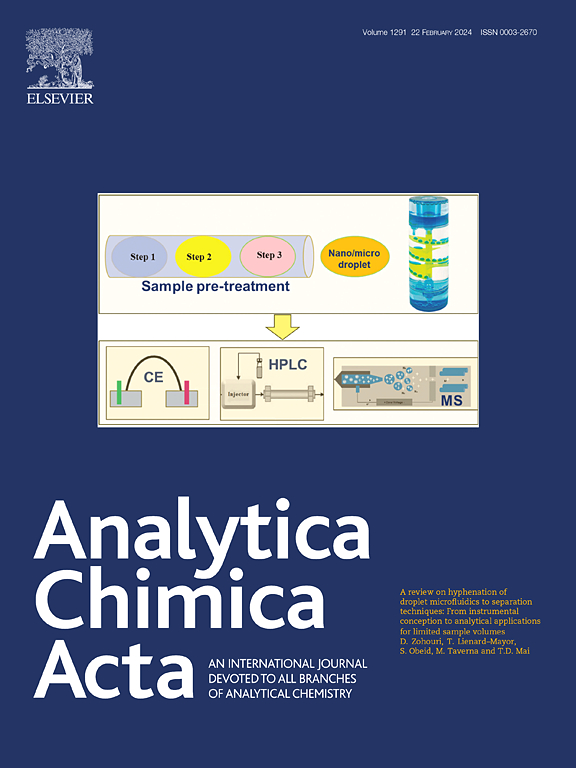光学活性纳米复合涂层熔喷口罩高灵敏度和选择性检测SARS-CoV-2刺突蛋白S1
IF 6
2区 化学
Q1 CHEMISTRY, ANALYTICAL
引用次数: 0
摘要
通过简便、快速和光学的方法检测病毒,包括冠状病毒(SARS-CoV-2),对控制大流行非常重要。在这方面,光学活性纳米材料和纳米颗粒(NPs)是一个明智的选择,因为它们具有长期稳定性,易于功能化和修饰。本文设计并合成了一种基于NiFe层状双氢氧化物(LDH)和ZIF-67金属有机骨架(MOF)的纳米复合材料,并将其装饰在熔喷掩膜表面。所制备的纳米复合材料在625 nm处具有荧光发射。添加CuO NPs后,纳米复合材料对SARS-CoV-2刺突蛋白S1的选择性增强。NiFe LDH@ZIF-67@CuO纳米复合材料对SARS-CoV-2刺突蛋白S1的检测限(LOD)分别为1.5 nM和24.5 nM, NiFe LDH@ZIF-67@CuO修饰在熔喷表面。此外,当存在潜在的竞争对手和其他类型的病原体时,包括甲型流感病毒和乙型流感病毒,金黄色葡萄球菌,甚至阳离子/大分子,荧光强度变化有40%以上的差异。本文章由计算机程序翻译,如有差异,请以英文原文为准。


Highly sensitive and selective detection of SARS-CoV-2 spike protein S1 using optically-active nanocomposite-coated melt-blown masks
Detection of viruses, including coronavirus (SARS-CoV-2), via facile, fast, and optical methods is highly important to control pandemics. In this regard, optically-active nanomaterials and nanoparticles (NPs) are a wise choice due to their long-term stability, ease of functionalization, and modifications. In this work, a nanocomposite based on NiFe layered double hydroxide (LDH) and ZIF-67 metal-organic framework (MOF) was designed and synthesized, and decorated on the surface of the melt-blown mask. The developed nanocomposite has a fluorescence emission at 625 nm. The selectivity of the nanocomposite towards the SARS-CoV-2 spike protein S1 was increased by adding CuO NPs. The limit of detection (LOD) of 1.5 nM and 24.5 nM against SARS-CoV-2 spike protein S1 was recorded by NiFe LDH@ZIF-67@CuO nanocomposite, and NiFe LDH@ZIF-67@CuO decorated on the surface of melt-blown. Also, in the presence of potential competitors and other types of pathogens, including Influenza virus types A and B, Staphylococcus aureus bacteria, and even cations/macromolecules, the fluorescence intensity changes had more than 40 % difference.
求助全文
通过发布文献求助,成功后即可免费获取论文全文。
去求助
来源期刊

Analytica Chimica Acta
化学-分析化学
CiteScore
10.40
自引率
6.50%
发文量
1081
审稿时长
38 days
期刊介绍:
Analytica Chimica Acta has an open access mirror journal Analytica Chimica Acta: X, sharing the same aims and scope, editorial team, submission system and rigorous peer review.
Analytica Chimica Acta provides a forum for the rapid publication of original research, and critical, comprehensive reviews dealing with all aspects of fundamental and applied modern analytical chemistry. The journal welcomes the submission of research papers which report studies concerning the development of new and significant analytical methodologies. In determining the suitability of submitted articles for publication, particular scrutiny will be placed on the degree of novelty and impact of the research and the extent to which it adds to the existing body of knowledge in analytical chemistry.
 求助内容:
求助内容: 应助结果提醒方式:
应助结果提醒方式:


